
|
Uranian Astrology and Symmetrical Astrology Features in Sirius Copyright © 2009 All Rights Reserved by David Cochrane Below are briefly summarized some of main Uranian astrology and symmetrical astrology features in Sirius 1.0. There are also additional features that are not mentioned. The description below, however, does provide a good overall view of the features that are available. We have also mentioned which of these features are in Kepler 7. Note that future versions of Sirius and Kepler are likely to have more features. Introduction to Uranian Astrology and Symmetrical AstrologyUranian astrology, also known as the Hamburg School, was developed by Alfred Witte and his colleagues. Some of the main features of this approach to astrological interpretation are the use of planetary pictures, midpoint structures, and the 8 hypothetical transneptunians. One of the main tools used by Witte and his colleagues are dials. Also, the graphic ephemeris popularized by Reinhold Ebertin in cosmobiology is used by many Uranian astrologers. The term "symmetrical astrology" is a newer term that is applied to an emphasis on the use of planetary pictures, direct midpoint structures, and other configurations that exhibit symmetrical qualities. As Witte's ideas have become applied to other areas such as AstroLocality, and the relationship of planetary pictures to other theoretical concepts such as composite charts and arabic parts (as explained below), and also as new tools have been developed to complement or to replace the use of dials, Uranian astrology has evolved for some astrologers in ways beyond those originally formulated by Witte and his colleagues. The term "symmetrical astrology" for this broader and more modern application of principles articulated by the early Uranian astrologers helps distinguish these progressive developments from the doctrines established by Witte and his colleagues. In the description of features below we refer to them as features of "symmetrical astrology" as this term tends to include any features related to the use of techniques introduced or emphasized in Uranian astrology but applied to a broad range of areas and utilizing additional tools to the dials and other tools that were the mainstay in the early development of Uranian astrology. An accelerated development of computerized astrological calculations began in the early 1980's as home computers at reasonably affordable prices became available. Software development from Cosmic Patterns Software and other astrology software companies has continued at an intense pace since then and astrological software continues to improve at a fairly fast pace. The description of features below is of Sirius 1.0 and future versions will have improved features. Symmetrical Astrology Features of SiriusThe following descriptions are very brief: 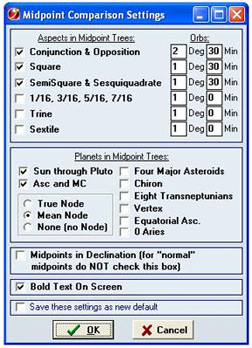
1. Midpoint Structures In the Birth Chart and Between Charts: Shown below is a section of the midpoint structures displayed (the report continues; we are showing just the first few lines):  2. Planetary Pictures in the Birth Chart and Between Charts: 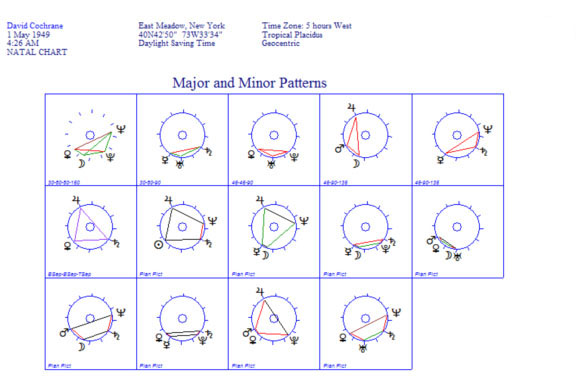 You can also display planetary patterns formed between two charts. Shown below are planetary pictures formed by two planets in one chart and two planets in the other chart. The names are color coded to indicate which planets are from which chart 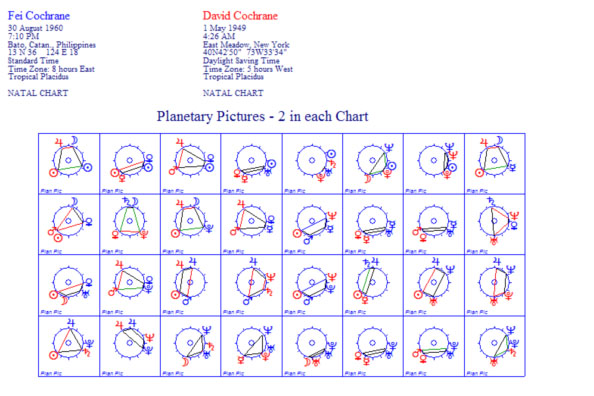 Shown below are planetary pictures formed by 3 planets in one chart and 1 planet in the other chart.  3. Transiting and Progressed Midpoint Structures:  4. Transiting and Progressed Planetary Pictures: Shown below are planetary pictures formed between the transits and progressed chart and that involve the same planets: 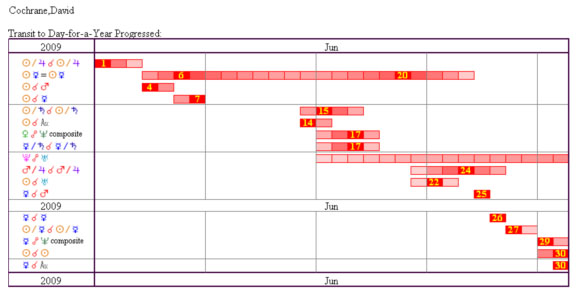 The first influence displayed shows that the transiting Sun/Jupiter midpoint is conjunct the progressed Sun/Jupiter midpoint on 1 June 2009. The next influence shows that the transiting Sun-Mercury angle is the same as the progressed Sun-Mercury angle on 6 June 2009 and 20 June 2009 and it is in orb from 4 June 2009 to 24 June 2009. The 7th influence in the listing shows the third kind of planetary picture that can form between the same two planets: an opposition of Venus and Neptune in the composite chart of the transiting planets and progressed planets. This feature of Sirius allows you to easily see the most important planetary pictures being formed between transiting and natal planets, or between progressed and natal planets, or as shown above beween transiting and progressed planets. The ability to obtained this detailed and specific information in a very easy-to-read format makes it possible for many astrologers to see astrological influences based on the principles of symmetrical astrology and Uranian astrology much more easily than was possible before. If you would like to read more about these especially important planetary pictures you can read The Three Symmetries and Secrets of Astrological Compatibility article. 5. AstroMaps, AstroSignature Forecast Graph, Research: 6. Graphic Ephemeris: 7. Interactive 90 Degree Dials (or 45-degree, etc.): 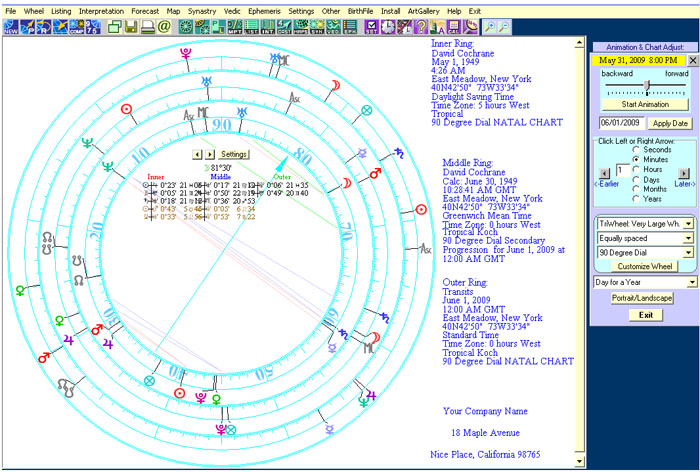 On the panel on the right side you can move the chart forward or backward in time, select a different progressed chart, switch between a TriWheel and 3 Separte wheels, and select a few other things as well. In the center of the TriWheel you can grab the arrow and rotate it to point it to different points on the dial and display the midpoint structures formed in each of the 3 charts. There is also an interactive dial of a single chart, two charts (natal and transits or natal and progressed, and 4 charts (natal, progressed, return, and transits or of a natal chart, 2 progressions, and transits). 8. Other Uranian and Symmetrical Astrology Features:
|

 AUTHOR:
AUTHOR: 